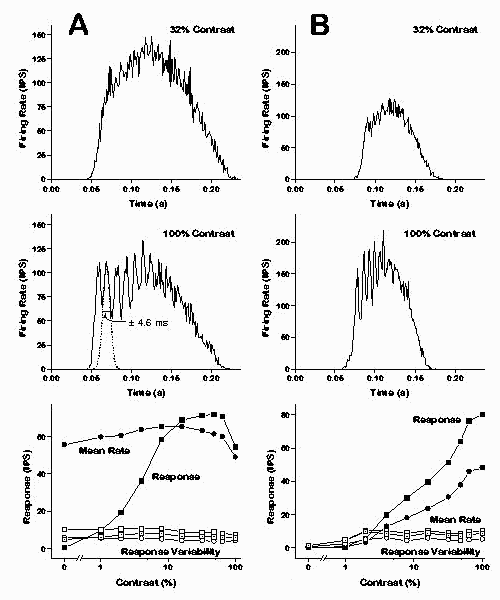Response variability and timing precision of spike trains
Response variability and timing precision of
neuronal spike trains in vivo
Daniel S. Reich, Jonathan D. Victor, Bruce W. Knight, Tsuyoshi Ozaki,
and Ehud Kaplan
J. Neurophysiol. 77, 2836-2841 (1997)
Abstract
We report that neuronal spike trains can exhibit high,
stimulus-dependent temporal precision even while the trial-to-trial
response variability, measured in several traditional ways,
remains substantially independent of the stimulus.
We show that retinal ganglion cells and neurons
in the lateral geniculate nucleus (LGN) of cats in vivo
display both of these aspects of firing behavior,
which have previously been reported to be contradictory.
We develop a simple model which treats neurons as
"leaky" integrate-and-fire devices and show that it, too, can exhibit
both behaviors. We consider the implications of our findings
for the problem of neural coding.
Stimulus-independent variability coexists with stimulus-dependent, precise firing times
This figure (Figure 2 from the paper) shows that neurons in vivo can fire action potentials at precise, reproducible times for some stimuli and not for others, even while the response variability, measured in several traditional ways, is stimulus-independent.

(A) Peri-stimulus time histograms (PSTHs) from an X-type, ON-center retinal ganglion cell recorded as S-potentials in the cat LGN. The vertical axis represents the firing rate in impulses per second (IPS) in each 1 ms bin. The stimulus was a drifting grating (4 Hz, 1.2 cycles/degree, 1024 cycles). PSTHs are shown for the responses to stimuli at 32% and 100% contrast. The bottom plot shows the cell's response vs. contrast, on a semilogarithmic scale. Five data points are plotted for each contrast: the mean firing rate (filled circles); the amplitude of the mean Fourier fundamental (filled squares); the variability of the mean rate (open circles); the variability of the Fourier fundamentals (open squares); and the phase-independent variability of the Fourier fundamentals (squares with a dot in the center). (B) As in (A), but here the cell is an X-type, OFF-center retinal ganglion cell stimulated with a drifting grating at 32% and 100% contrast (4 Hz, 1.05 cycles/degree, 1024 cycles).
Download the manuscript, as gzipped Postscript
Download the manuscript, as pdf
Related publication
Another related publication
Publications related to spike train dynamics
Return to publications list
